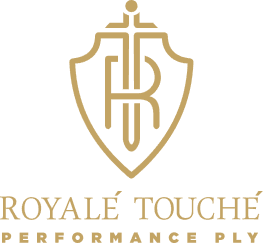
The Process of Manufacturing Blockboard: An Explanation of How Strong Boards are Made

October 18, 2025
Strength and durability are crucial measures of longevity for finished products in the world of furniture and for interior designers. One material that provides a high degree of reliability is blockboard, a popular choice in the making of wardrobes, tables, doors, cabinets, and Blockboard shelves. At Royale Touche, we take great pride in the quality of each and every panel that we manufacture. Following the blockboard manufacturing process involved in producing blockboard can help to clarify why our boards are strong, stable, and beautiful. In this article, we will take you through the blockboard-making process step by step to show how blockboard is made.
What is Blockboard?
Prior to taking you through the blockboard manufacturing process of blockboard, it is important to understand what blockboard is manufactured from. Blockboard is an engineered wood product that is constructed by gluing strips of soft or hardwood together in the core, sandwiched between a layer of high-quality veneer. This design not only makes it a strong board, but also extremely light and resistant to twisting or bowing. Its unique board structure makes it suitable for furniture and interior applications that are designed for heavy use.
Steps by Step Process of Blockboard Manufacturing
Raw Material Selection
The first step of the blockboard manufacturing process is the selection of raw materials. To make a blockboard, we select the highest quality timber strips for the core and the best veneer available for the faces of the blockboard. The selection of raw materials is critical to the final product, as the durability, strength, and finish of the final product will depend on the quality of the raw materials. Royale Touche will only use the highest quality wood to ensure the block board making process produces panels that meet the expected standards in the industry.
Preparing the Core Blocks
After choosing the raw materials, the softwood or hardwood strips are cut to a specific size. The different types of core blocks are laid out in the proper orientation for strength. In most cases, the grain direction of the wood in the core runs along the board's length. Proper grain orientation with core blocks is very important during the blockboard manufacturing process to ensure that the board is capable of supporting heavy loads without bending or cracking.
Adhesive Application
After the core blocks are prepared, the next step in the blockboard manufacturing process is to apply adhesive to the core blocks and the surface veneers. For attaching the core strips together and to the top and bottom veneers, a special water-resistant glue is utilized. This adhesive is durable and can withstand moisture and building envelope conditions such as temperature changes. The glue will ensure that the blockboard manufacturing process produces a cohesive structure with no weak points.
Pressing and Hot Pressing
After applying the adhesive, assembled blockboard will be placed into a hydraulic press. The blockboard manufacturing process will also involve hot pressing the boards under pressure to ensure that even bonding occurs between the core strips and the surface veneers. The pressing process also aids in removing air pockets and ensures the adhesive cures properly while providing a smooth and flat surface. Hot pressing is required for blockboards to get the strength and stability that allow them to be used in quality furniture.
Trimming and Sanding
After the pressing process is completed, the blockboards will be trimmed to remove the excess edges and to give the boards a uniform look. The edges are then squared, and the surface of the board is sanded to obtain a smooth surface, which is an important factor in the blockboard manufacturing process. Sanding prepares the board for further finish, such as lamination or painting. In addition, sanding helps with the overall appearance of the blockboard and with ease of handling for the furniture.
Quality Control
At Royale Touche Plywood, using quality control is an important part of the block board making process. Each board is then thoroughly inspected for defects like cracks in the boards, uneven surfaces, or weak bonding between the core strips or strips. The boards are then checked for other parameters such as thickness, moisture content, and density in order for our customers to receive boards that meet our quality control standards. This process ensures that blockboard will be reliable and long-lasting for every application.
Finishing
The final step in making the blockboard is finishing the boards. The boards are laminated with high-quality materials, polished, or coated with protective finishes to meet the end-use requirements. Lamination not only helps durability and strength of the blocks, but provides a premium look, making it a superb modern furniture board. The finishing stage guarantees the block board making process creates attractive, smooth, and ready-to-use boards for indoor purposes.
Advantages of a Proper Blockboard Manufacturing Process
A clear blockboard manufacturing process gives benefits as follows:
Strength and Stability
Explaining a process by which the blocks in the core and the adhesive is applied directly, will allow for the production of strong, non-warping blocks
Lightweight
Blockboard is lighter than solid wood material, even though strong, which adds ease of handling and installation.
Durability
High-quality adhesives and veneers will resist moisture, insect, and environmental conditions.
Versatility
The finished boards can be finished to be used to build wardrobes, cabinets, doors, tables, and decorative panels.
Cost-Effective
Using the timber with care will reduce waste thus keeping the product economical.
Blockboard Applications
Understanding of the blockboard manufacturing process also explains popularity in uses of furniture production. The uses of blockboard include:
Wardrobes and Cabinets
This application of blockboard provides structural support while allowing for a good finish to be applied to the face.
Doors and Partitions
A product that is durable and resistant to warping, ideal for indoor door applications.
Tables and Worktops
A product that is strong enough to withstand heavy loads when used in tables — including office furniture.
Paneling
The smooth surface of the product allows for a great laminate, paint, or veneer finish to be applied.
Conclusion
The blockboard manufacturing process is an intricate combination of selecting quality raw materials, a carefully executed cutting plan, bonding with adhesive, hot pressing, sanding, inspection, and finishing. Royale Touche has boards manufactured with intention and care, to ensure each panel shows strength, durability, and is ready for high-end furniture applications. Each process step of the block board making process and finish will be monitored closely to ensure boards that are strong, reliable, and aesthetically pleasing. If you choose blockboards for your furniture needs, then an understanding of the process backing up the board will ensure you have boards that convey durability, lightweight form, with lasting beauty.
Focusing on a robust blockboard manufacturing process, Royale Touche continues to deliver boards that stand the test of time and give your furniture the strength and aesthetic that it rightly deserves.
Related Blogs
Major Differences Between Blockboard and MDF
Pine Block Board: A Versatile Material for Interior Design
What are the Major Differences between Block board and Plywood
Understanding the Differences Between Pine Blockboard and Other Blockboards
Difference Between Calibrated Hardwood Blockboard and Regular Blockboard
